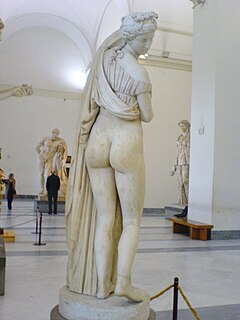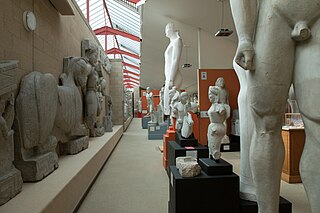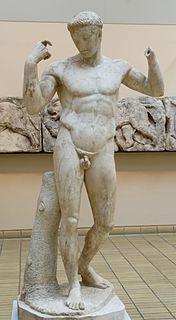
The Farnese Diadumenos is a 1st-century AD, slightly smaller than lifesize, Roman marble copy of Polyclitus's Diadumenos sculpture. Once in the Farnese collection, it is now in the British Museum. [1]

The Farnese Diadumenos is a 1st-century AD, slightly smaller than lifesize, Roman marble copy of Polyclitus's Diadumenos sculpture. Once in the Farnese collection, it is now in the British Museum. [1]
| | This article about a sculpture in the United Kingdom is a stub. You can help Wikipedia by expanding it. |

Polykleitos was an ancient Greek sculptor in bronze of the 5th century BC. Alongside the Athenian sculptors Pheidias, Myron and Praxiteles, he is considered one of the most important sculptors of classical antiquity. The 4th century BC catalogue attributed to Xenocrates, which was Pliny's guide in matters of art, ranked him between Pheidias and Myron. He is particularly known for his lost treatise, the Canon of Polykleitos, setting out his mathematical basis of an idealised male body shape.

Palazzo Farnese or Farnese Palace is one of the most important High Renaissance palaces in Rome. Owned by the Italian Republic, it was given to the French government in 1936 for a period of 99 years, and currently serves as the French embassy in Italy.

The Farnese Hercules is an ancient statue of Hercules, probably an enlarged copy made in the early third century AD and signed by Glykon, who is otherwise unknown; the name is Greek but he may have worked in Rome. Like many other Ancient Roman sculptures it is a copy or version of a much older Greek original that was well known, in this case a bronze by Lysippos that would have been made in the fourth century BC. This original survived for over 1500 years until it was melted down by Crusaders in 1205 during the Sack of Constantinople. The enlarged copy was made for the Baths of Caracalla in Rome, where the statue was recovered in 1546, and is now in the Museo Archeologico Nazionale in Naples. The heroically-scaled Hercules is one of the most famous sculptures of antiquity, and has fixed the image of the mythic hero in the European imagination.

The Farnese Bull, formerly in the Farnese collection in Rome, is a massive Roman elaborated copy of a Hellenistic sculpture. It is the largest single sculpture yet recovered from antiquity. Along with the rest of the Farnese antiquities, it has been since 1826 in the collection of the Museo Archeologico Nazionale Napoli in Naples, inv. no. 6002, though in recent years sometimes displayed at the Museo di Capodimonte across the city. The sculpture in Naples is much restored, and includes around the base a child, a dog, and other animals not apparently in the original composition, which is known from versions in other media.

Odoardo Farnese was an Italian nobleman, the second son of Alessandro Farnese, Duke of Parma and Maria of Portugal, known for his patronage of the arts. He became a Cardinal of the Roman Catholic Church in 1591, and briefly acted as regent of the Duchy of Parma and Piacenza for his nephew Odoardo from 1622 to 1626.

The Farnese Atlas is a 2nd-century AD Roman marble sculpture of Atlas holding up a celestial globe. Probably a copy of an earlier work of the Hellenistic period, it is the oldest extant statue of Atlas, a Titan of Greek mythology who is represented in earlier Greek vase painting, and the oldest known representation of the celestial spheres and the classical constellations. The sculpture is at the National Archaeological Museum of Naples, in Italy.

The National Archaeological Museum of Naples is an important Italian archaeological museum, particularly for ancient Roman remains. Its collection includes works from Greek, Roman and Renaissance times, and especially Roman artifacts from nearby Pompeii, Stabiae and Herculaneum. It was formerly the Real Museo Borbonico.

I Modi, also known as The Sixteen Pleasures or under the Latin title De omnibus Veneris Schematibus, is a famous erotic book of the Italian Renaissance in which a series of sexual positions were explicitly depicted in engravings. While the original edition was apparently completely destroyed by the Catholic Church, fragments of a later edition survived. The second edition was accompanied by sonnets written by Pietro Aretino, which described the sexual acts depicted. The original illustrations were probably copied by Agostino Carracci, whose version survives.

The Diadumenos ("diadem-bearer"), together with the Doryphoros, are two of the most famous figural types of the sculptor Polyclitus, forming a basic pattern of Ancient Greek sculpture that all present strictly idealised representations of young male athletes in a convincingly naturalistic manner.

The Palazzo Spada is a palace located on Piazza di Capo Ferro #13 in the rione Regola of Rome, Italy. Standing very close to the Palazzo Farnese, it has a garden facing towards the Tiber river.

Museo di Capodimonte is an art museum located in the Palace of Capodimonte, a grand Bourbon palazzo in Naples, Italy. The museum is the prime repository of Neapolitan painting and decorative art, with several important works from other Italian schools of painting, and some important ancient Roman sculptures. It is one of the largest museums in Italy.

Palazzo Farnese is a palace in Piacenza, northern Italy.

Francesco I d'Este was Duke of Modena and Reggio from 1629 until his death. The eldest son of Alfonso III d'Este, he became reigning duke after his father's abdication.

Giovanni Bernardi, also known as Giovanni da Castel Bolognese and as Giovanni da Castelbolognese, was an Italian gem engraver and medallist who was born in Castel Bolognese, Italy. He was the son of a goldsmith and by 1530 had moved to Rome, where he had a position in the Papal mint, which also allowed him time to work for other patrons. These included Cardinal Ippolito de' Medici (1511–35), Pope Clement VII (1523–34), Cardinal Alessandro Farnese, the future Pope Paul III, as well as his grandson, also called Cardinal Alessandro Farnese. He was "a skillful composer of elegant nudes in elaborate scenes".

Carlo Albacini was an Italian sculptor and restorer of Ancient Roman sculpture.

The Museum of Classical Archaeology is a museum in Cambridge, run by the Faculty of Classics of the University of Cambridge, England. Since 1983, it has been located in a purpose-built gallery on the first floor of the Faculty of Classics on the Sidgwick Site of the University.

Ancient Rome is a name given to each of three almost identical paintings by Italian artist Giovanni Paolo Panini, produced as pendant paintings to Modern Rome for his patron, the comte de Stainville, in the 1750s.

The classical sculptures in the Farnese Collection, one aspect of this large art collection, are one of the first collections of artistic items from Greco-Roman Antiquity. It includes some of the most influential classical works, including the sculptures that were part of the Farnese Marbles, their collection of statuary, which includes world-famous works like the Farnese Hercules, Farnese Cup, Farnese Bull and the Farnese Atlas. These statues are now displayed in the Naples National Archaeological Museum in Italy with some in the British Museum in London.

The Vaison Diadumenos is a life size marble statue of an athlete found at the Roman city of Vaison, southern France. Since 1870, it has been part of the British Museum's collection.